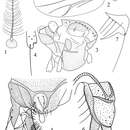pt-BR
nomes no trilho de navegação


Polypedilum is a genus of non-biting midges in the subfamily Chironominae of the bloodworm family Chironomidae. This is probably the most species-rich of all chironomid genera. Larvae of Polypedilum may also be among the most abundant invertebrates in eutrophic ponds, reaching densities of up to 1200 larvae per square meter.[2]
{{cite journal}}: CS1 maint: multiple names: authors list (link) Polypedilum is a genus of non-biting midges in the subfamily Chironominae of the bloodworm family Chironomidae. This is probably the most species-rich of all chironomid genera. Larvae of Polypedilum may also be among the most abundant invertebrates in eutrophic ponds, reaching densities of up to 1200 larvae per square meter.
Polypedilum est un genre de moucherons non piqueurs de la famille des Chironomidae, de la sous-famille Chironominae, de la tribu des Chironomini. C'est probablement le genre de chironomes le plus riche en espèces. Les larves de Polypedilum sont également probablement parmi les invertébrés les plus abondants dans les étangs eutrophes, atteignant des densités allant jusqu'à 1200 larves par mètre carré[1].
Polypedilum est un genre de moucherons non piqueurs de la famille des Chironomidae, de la sous-famille Chironominae, de la tribu des Chironomini. C'est probablement le genre de chironomes le plus riche en espèces. Les larves de Polypedilum sont également probablement parmi les invertébrés les plus abondants dans les étangs eutrophes, atteignant des densités allant jusqu'à 1200 larves par mètre carré.